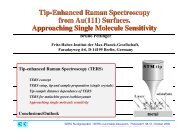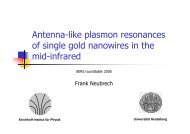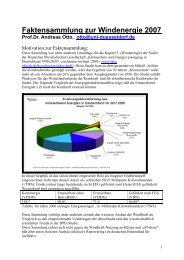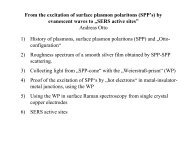Download - Heinrich-Heine-Universität Düsseldorf
Download - Heinrich-Heine-Universität Düsseldorf
Download - Heinrich-Heine-Universität Düsseldorf
- No tags were found...
You also want an ePaper? Increase the reach of your titles
YUMPU automatically turns print PDFs into web optimized ePapers that Google loves.
phys. stat. sol. 1Enhanced Infrared Absorption of SERS-active lines of ethyleneon CuM. SINTHER (a), A. PUCCI 1 )(a),A.OTTO (b), A. PRIEBE (a), S. DIEZ (a), andG. FAHSOLD (a)(a) Kirchhoff-Institut für Physik, Ruprecht-Karls-<strong>Universität</strong> Heidelberg, Albert-Ueberle-Straße 3-5, D-69120 Heidelberg, Germany(b) Institut für Physik der kondensierten Materie, <strong>Heinrich</strong>-<strong>Heine</strong>-<strong>Universität</strong> <strong>Düsseldorf</strong>,<strong>Universität</strong>sstraße 1, D-40225 <strong>Düsseldorf</strong>, Germany(SubmittedAugust 16, 2001)Subject classification: 68.43.Pq; 73.30.-j; 33.70.Ca; S1.3Vibrational modes of adsorbates on rough metal films can show surface enhanced Raman scattering(SERS) as well as surface enhancedinfrared(IR) absorption (SEIRA). Both effects are a consequenceof fieldenhancement andof a so-calledchemical effect. Our experiments show that chemical contributionsto SERS andto SEIRA from ethylene on Cu may have the same origin. We investigatedethyleneadsorbed on ultrathin Cu films at about 100 K and below with IR transmission spectroscopy. At exposuresup to 2L the IR spectra show lines only at the positions of the very intense SERS E-bands. Athigher exposures lines at the frequencies of the infraredactive vibrations of ethylene molecules develop.All lines are stronger than one expects from molecular IR activities. Co-adsorption experimentsperformedwith ethylene andCO show that E-lines in SEIRA do not occur after pre-coverage of Cuwith CO.Introduction The so-calledchemical enhancement of the Raman intensity of adsorbedspeciesnot present for species in the secondandmulti-layers is experimentally well established[1]. By now it is evident, that this signal originates from species adsorbed at or near surfacedefects but not from adsorbates on perfect low index faces of Cu single crystals [2]. Ethyleneon cold-deposited copper films displays the same "first layer bands" at defect sites in SERSandsurface enhancedinfraredabsorption (SEIRA) [3]. By closer inspection of infrared(IR)transmission spectra it turnedout that SEIRA lines can have an asymmetric line shape [4]andthe broadbandtransmission can be changedrelative to that of the bare metal film [5].Both the effects indicate dynamic interaction of adsorbate vibrations with excitations of freecharge carriers. For vibrational dipole moments that can interact with the external field thisdynamic interaction is a Fano-type one andtherefore it shouldcontribute to SEIRA (andprobably to SERS). The SEIRA line shapes couldbe strongly influencedby film transportproperties, e.g. the asymmetry of the CO stretch mode has a maximum near the percolationthresholdof the metal film [4]. The properties of free charge carriers in ultrathin metal filmsare different to those in bulk metals because of size effects [6]. Film roughness additionallyalters film properties, i.e. also the probability for the excitation of electron-hole pairs. ForSEIRA andSERS this shouldbe as important as for fieldenhancement between metal grains.In this paper we present anddiscuss our IR spectroscopic results on ethylene adsorption onultrathin copper films on KBr(001). Ethylene is known to adsorb via π-bonding on Cu(111)1 ) Corresponding author; Phone: +49 6221 549450, Fax: +49 6221 549262, e-mail:a.pucci@urz.uni-hd.de
phys. stat. sol. 2[7] andCu(100) [8] with the molecular plane parallel to the surface. For Cu(110) the ethylenemolecules shouldalso lie flatly on the surface but it is not known whether the moleculeis situated on top or at a twofold bridge site of the Cu-ridges in [110] direction [9]. The socalledπσ-parameter of the C 2 H 4 species adsorbed on cold-deposited copper with lower vibrationalCC-stretch andCH 2 -scissor vibrations (so-calledE-species, which are not presentat smooth surfaces is 0.26 [10]. That means ethylene physisorbes on the Cu surfaces. For theeffects under consideration it is important to note that the lowest unoccupied molecular orbitalB 2g of ethylene has tails of its adsorbate induced density of states at the Fermi level[11]. Therefore any modulation of the CC-bond length according to the πσ-parameter to themetal substrate shouldchange the occupation of this orbital.The free ethylene molecule has twelve vibrational modes, five of them are IR active, six areRaman active, andone is silent [12, 13]. For physisorbedethylene molecules these selectionrules for IR andRaman activity may be slightly violated, e.g. on a single crystal surface witha different symmetry. Raman scattering from ethylene adsorbed on rough copper surfacesshow that some of the Raman active modes are split into so-called N- (N = normal) and E-modes (E = extra) [3]. The E-modes are the most enhanced modes in SERS [3]. The RamanN-modes closely above the E-lines have frequencies of about 940 cm -1 (B 2g ), 1330 cm -1 (A g ),and1615 cm -1 (A g ), respectively. Interestingly, these three vibrations do not involve C-Hstretching but a modulation of the C=C bond (stretching for 1330 cm -1 and1615 cm -1 ,bendingfor 940 cm -1 ).Experiment The experiments were conducted in an ultra-high vacuum (UHV) chamberwhich is connectedby Viton-O-Ring sealedIR-windows with a FTIR-spectrometer (BRU-KER IFS66v/S with LN 2 -cooledMCT-detector). The spectrometer andthe optical path to thedetector were evacuated to 3 mbar, the base pressure in the UHV-chamber was below 2 x10 -10 mbar. For film preparation we useda water-cooledmetal vapor source (Omicron). Thedeposition rate was calibrated with a quartz microbalance. A leak valve was used for dosingadsorbates. All IR spectra were taken in transmission with normal incidence. The KBr(001)-crystals (TBL-Kelpin) were air-cleavedandtransferredto UHV within several minutes.Afterwards they were heated to 470 K for 4 h. The sample temperature was measured by achromel-alumel thermocouple attached to the sample holder. The copper films were depositedattwo different substrate temperatures (about 100 K andabout 40 K) with a depositionrate of about 0.1 nm/min. Due to a very oblique incidence of the broad copper beam in theseexperiments film thicknesses only have an accuracy of about ±15%. During evaporation IRtransmission spectra were taken with a resolution of 32 cm -1 . Each spectrum needed roughly14 seconds. For the subsequent adsorption experiments the sample was kept at a temperatureof about 100 K and40 K, respectively. Ethylene was exposedat a partial pressure of about 3x10 -8 mbar (as indicatedby a ionisation gauge, AML/tectra) andhada purity of 99.95vol.%. Carbon monoxide was exposed at a partial pressure of 2 x 10 -8 mbar andhada purityof 99.997 vol.%. The IR transmission spectra taken during gas exposure had a resolution of 2cm -1 andtook about 45 seconds. For comparison, we also measuredthe IR transmission ofKBr exposedto C 2 H 4 at about 40 K up to 53 L (ion gauge reading divided by the gauge factorof 2.14 for ethylene, 1L = 1.333 x 10 -4 Pa·s).
phys. stat. sol. 4Figure 3 shows the IR-transmission spectra of the subsequent exposure of three different Cufilms to ethylene at 100 K andabout 40 K, respectively. The spectra are referredto the uncoveredcopperfilms, the exposures are correctedfor the gauge factor of 2.14 for ethylene.800 1000 1200 1400 16002800 3000 32001,00610.7 L8939511277143615382971306430881,0046.0 L(a)1,0001,0023.6 L0,9951,0003.6 L6.0 L0,99810.7 L0,9901,02 8.3 L5.9 L1.2 L1,00relative transmittance1,012.6 L1.2 L(b)2.6 L0,991,005.9 L8.3 L1,001.7 L1.7 L1,000,994.1 L4.1 L0,9911.6 L0,9816.5 L0,980,970,97(c)11.6 L0,960,960,9582312191340161416.5 L0,95800 1000 1200 1400 16002800 3000 3200wavenumber [cm -1 ]Fig. 3. Relative transmittance (a) of about 4 nm Cu grown at 100 K on KBr(001) during C 2 H 4 exposure(given in Langmuir L) at 100 K, (b) as (a) for 5.7 nm Cu, (c) relative transmittance of 5.4 nm Cugrown at 40 K on KBr(001) during C 2 H 4 exposure at 40 K
phys. stat. sol. 5In the IR-transmission spectra we also findthe SERS-E-modes at 893 cm -1 , 1277 cm -1 ,andat1538 cm -1 in goodagreement with the frequencies foundby Grewe et al. [14]. These modesfirstly arise with exposure. At higher exposures lines at the frequencies of IR active modes(from 950 cm -1 to 970 cm -1 andat 1436 cm -1 ) of solid ethylene develop already at 100 K. At40 K we observe these modes growing much faster with exposure andcompletedby theother IR active modes at 823 cm -1 andin the 3000 cm -1 region. At exposures above 10 L andbecause of exposure below the desorption temperature of the N-species at about 90 K [14]also the Raman N-lines at 1340 and1614 cm -1 andthe line at 1219 cm -1 (B 1g [12]) appear.The N-bands have positions close to those of the Raman bands in solid C 2 H 4 .Wedid notobserve such lines in IR spectroscopy of solidC 2 H 4 . Therefore the Raman bands in Fig. 3(c)must be assignedto a surface enhancement effect. In [14] the SERS-N-bands have beenassignedto species adsorbedon (111) facets.1,0041,003969 cm -11439 cm -12056 cm -1relative transmittance1,0021,0011,0000,9990,9980,9970.5 L0.7 L1.7 L1000 1500 2000wavenumber [cm -1 ]COFig. 4. Relative transmittance at 100 K during ethylene exposure up to saturation of the spectralchanges. The reference is the substrate, i.e. the 5.1 nm thick Cu film preparedon KBr at 100 K afterCO exposure up to saturationComparing the signal strength (per Langmuir) of the normal IR-lines in Fig. 3(c) to those ofour ethylene ice (not shown here) we findan enhancement factor of at least two for the normalIR lines of ethylene on coldcondensedCu. Additionally, all strong lines are asymmetriclike Fano lines [17]. However, the E-lines are much broader than the normal IR lines indicatingeven stronger interaction with a continuum of electron-hole pair excitations from thesubstrate. With the assumption that the IR signal at saturation (13 L) corresponds to amonolayer of E-line species it follows from the peak area at 893 cm -1 in Fig. 3(c) an enhancementof one order of magnitude compared to the IR intensity of the correspondingRaman N-line (shoulder at 940 cm -1 ) per Langmuir. A higher enhancement is more probablebecause it is unreasonable that the whole film surface consists of adsorption sites for E-line
phys. stat. sol. 6species. In a recent adsorption experiment at 100 K with a 5.2 nm Cu film grown at about 40K we have founda two-times bigger intensity of E-lines at saturation regarding films grownat 100 K. For completeness it shouldbe mentionedthat ethylene exposure to a very smoothand well ordered copper film grown on Si(111) does not produce any observable IR-lines at100 K but comparable broadband changes [5]. This corresponds to the loss of the E-bands inSERS by annealing andthe assignment of the E-sites to "annealable sites" [14]. A moredetailed discussion of the IR lines including the slight frequency shifts and the broadbandchanges will be publishedin a forthcoming paper. For the assignments of all observedbandsin Fig. 3 see e.g. Table 1 in Ref. 14.Now we will experimentally check the suspicion that also in IR spectra the E-lines arecausedby species adsorbeddirectly on the metal surface. Therefore we performedcoadsorptionexperiments. The first of these experiments shows that the E-lines are not observableafter pre-exposure of the copper film to CO, see Fig. 4. Interestingly, the normal IRmodesdevelop. The IR-transmission spectrum of the subsequent exposure to ethylene showstwo normal IR-modes of ethylene. Additionally, the CO-stretch line with its frequency shiftdue to ethylene co-adsorption could be seen. The spectra shown in Fig. 4 are referred to thepre-exposedcopper film. More details will be publishedlater [18].Conclusions Our IR spectroscopic experiments confirm that particular adsorption sites onrough copper surfaces enable an increaseddynamic interaction of ethylene vibrations withexcitations of the charge carriers. For molecules at other adsorption sites this kind of interactionis smaller but still active. Because of fieldenhancement we can well observe these ethylenemodes in IR transmission spectroscopy in spite of screening by the metal film.Acknowledgement The authors gratefully acknowledge financial support by the DeutscheForschungsgemeinschaft.References[1] A. OTTO, I.MROZEK, H.GRABHORN, andW.AKEMANN, J. Phys.: Condens. Matter 4, 1143(1992).[2] A.GOUSSEV andA.OTTO, contribution to the 10th International conference of vibrations at surfaces2001, to be published[3] C. SIEMES, A.BRUCKBAUER, A.GOUSSEV, A.OTTO, M.SINTHER, andA.PUCCI, J. Raman Spectrosc.32, 231 (2001).[4] O. KRAUTH, G.FAHSOLD, N.MAGG, andA.PUCCI, J. of Chemical Physics 113, 6330 (2000).[5] G. FAHSOLD, M.SINTHER, A.PRIEBE, andA.PUCCI, in preparation.[6] e.g.N.TRIVEDI andN. W. ASHCROFT, Phys.RevB38, 12298 (1988).[7] R. LINKE, C.BECKER, TH. PELSTER, M.TANEMURA, andK.WANDELT, Surface Science 377-379,655 (1997).[8] D. ARVANITIS, L.WENZEL andK. BABERSCHKE, Phys. Rev. Lett. 59, 2435 (1987).[9] O. SCHAFF, A.P.J. STAMPFL, PH. HOFMANN, S.BAO, K-M.SCHINDLER, A.M.BRADSHAW, R.DAVIS, D.P.WOODRUFF, andV.FRITZSCHE, Surf.Sci.343, 201 (1995).[10] Ü. ERTÜRK andA. OTTO,Surf.Sci.179, 163 (1987).[11] B. N. J. PERSSON, Surface Science 269/270, 103 (1992).[12] M. CHIBA andG. VERGOTEN, J.ofMolecularStructure326, 35 (1994).
phys. stat. sol. 7[13] J. M. L. MARTIN andP.R. TAYLOR, Chemical Physics 248, 336 (1996).[14] J. GREWE, Ü.ERTÜRK, andA.OTTO, Langmuir 14, 696 (1998).[15] G. FAHSOLD, A.BARTEL, O.KRAUTH, N.MAGG, andA.PUCCI, Phys. Rev B 61, 14108 (2000).[16] K. SINGER, diploma thesis, Ruprecht-Karls-University Heidelberg 2000 (www.kip.uniheidelberg.de/Veroeffentlichungen).[17] for Fano-type line shapes in IR spectroscopy see e.g. D. C. LANGRETH, Phys. Rev. Lett. 54, 126(1985).[18] M. SINTHER, thesis, Ruprecht-Karls-University Heidelberg, in preparation.








